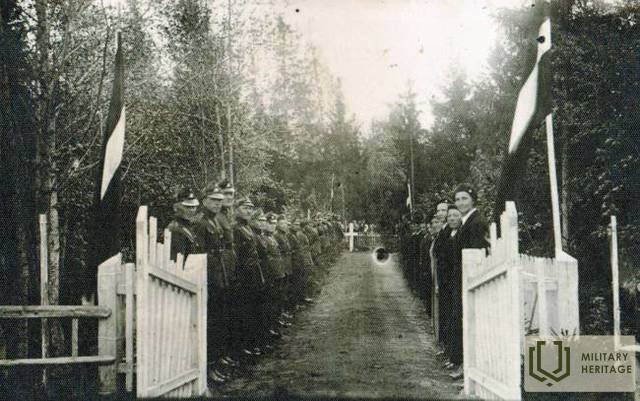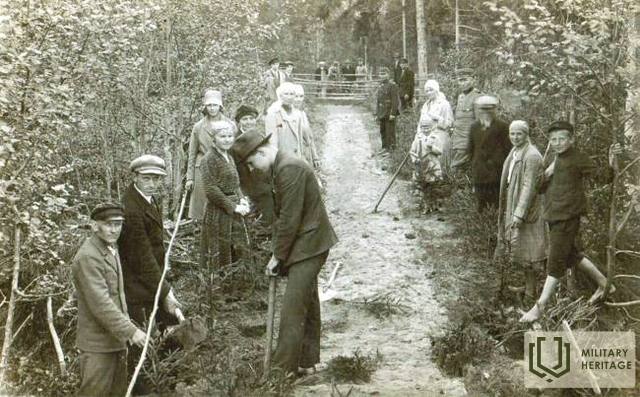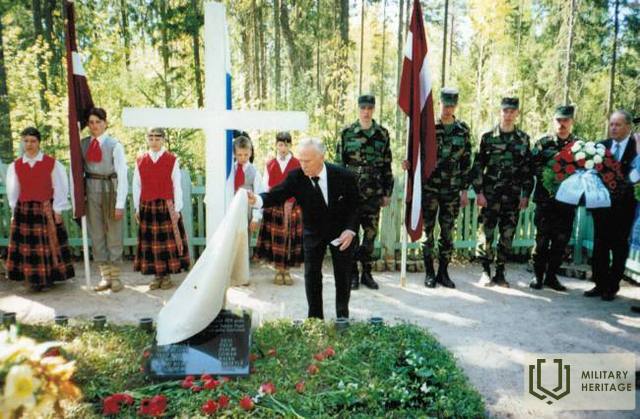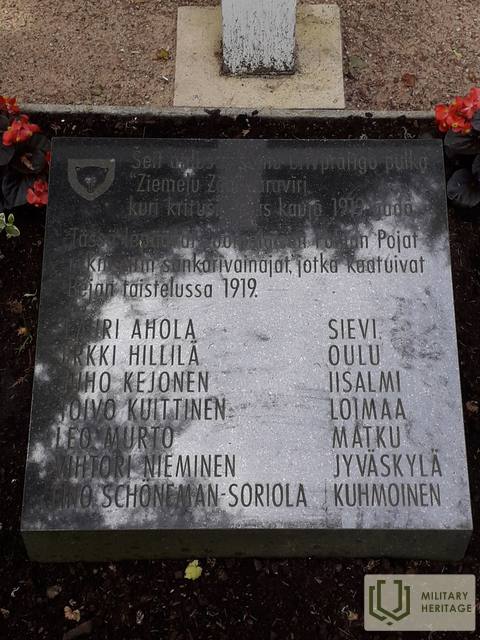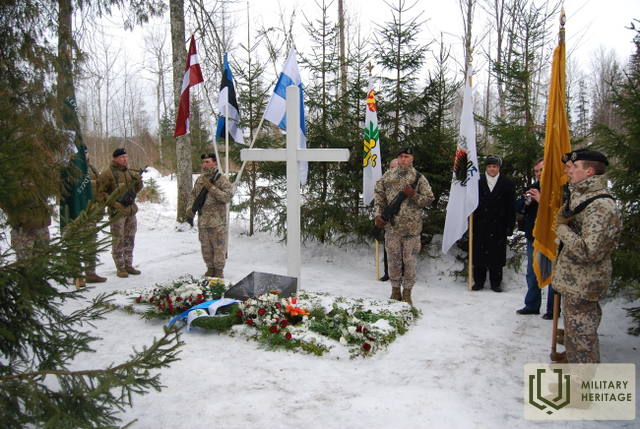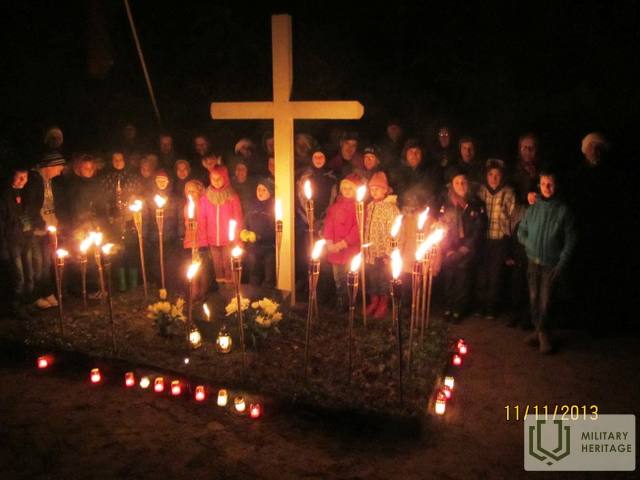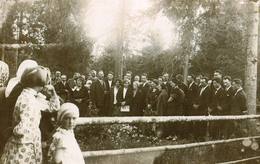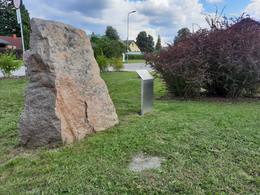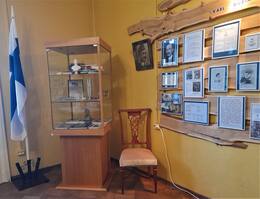Suomijos savanorių pulko „Šiaurės berniukai“ mūšis Bejoje
1919 m. vasario 23 d. Suomijos savanorių pulko „Šiaurės berniukai“ žvalgybos dalinys, tikėdamasis gauti papildomų ginklų ir amunicijos, atvyko į Bejos mokyklos daubą, kur įvyko susidūrimas su bolševikais (Babeckos mūšis). Šiame mūšyje žuvo 10 Suomijos pulko kareivių.
„Išvadavimo karo metu mano mamos brolis Eino Soriola mokėsi Kurkijo žemės ūkio mokykloje. Vieną dieną į mokyklą atėjo raudonieji ir paskelbė, kad ketina išžudyti kapitalistų šuniukus. 22 vaikinai buvo išvesti į kiemą ir sušaudyti, bet mamos broliui ir dar vienam vaikinui pavyko išlikti gyviems. Jie gulėjo sužeisti po bendražygių kūnų krūva. Kitas vaikinas, sužeistas į skrandį, vėliau buvo rastas ir subadytas durtuvais. Mamos brolis buvo sužeistas į plaučius, smarkiai nušalęs ir, dvi dienas vengęs ieškotojų, įlindo į tvarto mėšlo krūvą ir šildėsi pūvančiu arklių mėšlu. Slapstydamasis jis atvyko pas šeimą į Kuhmo, kurį buvo užėmę raudonieji. Netoliese buvo tuberkuliozės sanatorija, kurioje jis pagerino savo sveikatą. Čia Eino kartu su bendražygiu slapta rinko informaciją iš raudonųjų, ir tai ypač pasisekė, kai jis su raudonaisiais nuėjo į pirtį. Kalmina buvo išsiųsta. Jo mamos brolis Eino aktyviai dalyvavo...“ Kuhmo per visą Laisvės kovą, norėdamas atkeršyti už savo klasės draugų mirtį iš neapykantos. Pilietinio karo metu jis dalyvavo Aunu ir Vieni kampanijose, buvo sužeistas didžiajame Vuokkiniemen mūšyje 1918 m. rugsėjo 29 d. ir pasveikęs nebenorėjo vykti į Estijos mūšius. Tačiau Hansas Kalmas išsiuntė savo motinos broliui Eino laišką, kuriame priminė suomių savanoriams apie jų atvykimą ir tikėjosi atsakomųjų paslaugų išlaisvinant Estiją.
Mamos brolis išėjo Šiaurės berniukų taku, apie kurį rašė Hansas Kalmas. Dėdė tarnavo kulkosvaidžių grupės vadu, Valkos mūšyje buvo paaukštintas seržantu. Marienburgo žygio metu, dėl neteisingos informacijos, 56 vyrų grupė jojo į slėptuvę, kur 1919 m. vasario 23 d. buvo sužeistas mamos brolis. Jis liko su kulkosvaidžiu, pridengdamas likusių sužeistųjų pabėgimą arkliais. Dėdės kūnas nebuvo rastas. Apie jį taip pat nebuvo gauta jokių žinių.
Juho Kallinenas, kuris taip pat dalyvavo Aunu pilietiniame kare ir Estijos kampanijoje, papasakojo apie dėdės sužalojimą, nes mūšyje jie buvo toje pačioje grupėje. Senelis ir močiutė bandė sužinoti ką nors apie sūnaus likimą, bet visos pastangos buvo bergždžios. Paaiškėjo, kad jis žuvo Babeckos mūšyje ir buvo palaidotas su kitais žuvusiais suomių kareiviais vietos ūkininko Bērzinio žemėje Latvijoje.
Vaizdo įrašas apie suomių kareivių brolių kapus Bejoje ir Babeckos mūšį. https://www.youtube.com/watch?v=GbN5d9Y5ju8
Matti Matinolli pasakojimas apie savo brolį iš motinos pusės Eino Schōneman-Soriola, žuvusį 1919 m. vasario 23 d. Babeko (Bežos) mūšyje ir palaidotą Suomijos kareivių brolių kapinėse Bežoje. Bežos biblioteka.
https://timenote.info/lv/Finnish-Soldier-Grave-of-Bralu-Beja
https://lv.wikipedia.org/wiki/Bejaso_mūšis
https://www.sargs.lv/lv/starpkaru-periods/2015-01-10/somu-ziemelu-zenu-cinas-latvija#paskutinis komentaras
Susijusi laiko juosta
Susijusios temos
Susijusios vietos
Atminimo akmuo suomių savanorių pulkui „Šiaurės berniukai“
Įsikūręs Alūksnėje, Jāņkalna gatvėje 52, šalia Alūksnės siaurojo geležinkelio stoties.
2019 m. vasario 23 d., minint Latvijos Nepriklausomybės karo šimtmetį, Nepriklausomybės kovos tradicijų asociacijos (Suomija) iniciatyva buvo sukurta speciali atminimo vieta Suomijos savanoriams, žuvusiems už Latvijos nepriklausomybę, pagerbti, kurioje istorinius įvykius liudija specialus riedulys ir informacinė lenta. Atminimo akmuo į Alūksnę atkeliavo iš Suomijos – Salpos linijos, kuri buvo nutiesta 1940–1944 m., siekiant apsaugoti rytinę Suomijos sieną. 1200 km ilgio Salpos linija yra viena žymiausių nepriklausomos Suomijos gynybos linijų, taip pat vienas stipriausių ir geriausiai išsilaikiusių tokio tipo gynybos statinių Europoje po Antrojo pasaulinio karo.
Į Alūksnę atgabentas akmuo simbolizuoja dviejų tautų – suomių ir latvių – kovą už savo nepriklausomybę. Suomijos savanorių pulkas „Šiaurės berniukai“ išvyko padėti latviams ginti naujosios Latvijos valstybės laisvę. 1919 m. vasario 21 d. „Šiaurės berniukai“ dalyvavo įnirtingose kovose Alūksnės (Marienburgo) apylinkėse. Po penkias valandas trukusių mūšių netoli Alūksnės geležinkelio stoties suomiai užėmė Alūksnę. Šiame mūšyje žuvo 23 suomių savanoriai, daugelis buvo sužeisti.
Aprikių muziejaus kolekcijos ir raudonųjų partizanų veiklos zonos
Aprikių dvare įsikūręs Aprikių muziejus, kurio ekspozicijos pasakoja apie senovės regiono istoriją. Muziejuje eksponuojama ekspozicija apie Suomijos karinį veikėją Karlą Gustavą Mannerheimą – 175 muziejaus eksponatai, interaktyvus stendas „KGMannerheimas ir Apriki“ (trimis kalbomis – latvių, anglų ir suomių) su 6 skyriais – apie Aprikių dvarą, apie KGMannerheimą kaip vadą Žiemos kare, apie Suomijos laisvės mūšių vadą ir apie jo ryšį su Aprikais.
Muziejuje taip pat eksponuojami Antrojo pasaulinio karo eksponatai su vokiečių ir Raudonosios armijos simbolika, taip pat žemėlapis (raudonųjų partizanų veiklos zonos) ir raudonųjų partizanų aprašymai.
Aprikku dvaro (Apprikken) pastatų barokinis ansamblis iš pradžių buvo suformuotas prie Alokste upės XVIII a. XX a. pradžioje. Dvaro savininkas buvo Carlas Gustavas Mannerheimas, vėliau tapęs Suomijos prezidentu ir žinomas kaip legendinės Mannerheimo linijos – įtvirtinimų sistemos Žiemos karo metu – autorius.
Atminimo lenta suomių jėgeriams Šv. Trejybės katedroje Liepojoje
Suomijos jėgerių atminimo lenta yra Liepojos Šventosios Trejybės katedroje, Lielā iela 9.
Suomijos jėgeriai buvo Vokietijos imperijos dalinys, suformuotas iš Suomijos savanorių, kuris, pasivadinęs 27-uoju karališkuoju Prūsijos jėgerių batalionu, dalyvavo Pirmojo pasaulinio karo mūšiuose Latvijos rytų fronte 1916–1917 m.
Pirmojo pasaulinio karo metu Suomijos Didžioji Kunigaikštystė buvo Rusijos imperijos dalis, ir daugelis suomių siekė Vokietijos pergalės kare, kad paskatintų nepriklausomos valstybės sukūrimą. 1914 m. lapkričio 20 d. Helsinkyje buvo įkurtas Suomijos nepriklausomybės judėjimas, kuris taip pat planavo suformuoti nepriklausomos valstybės ginkluotąsias pajėgas. Kai Vokietijos vyriausybė 1915 m. sausį patvirtino esanti pasirengusi apmokyti suomius, prasidėjo savanorių verbavimas, o iki 1916 m. pavasario Vokietijoje buvo dislokuota beveik 2000 kareivių, kurie buvo pavadinti 27-uoju Karališkųjų Prūsijos jėgerių batalionu.
Nuo 1916 m. birželio mėn. batalionas buvo Rygos fronte, kur buvo perkeltas į Liepoją, ir veikė iki 1917 m. kovo mėn. Po Vasario revoliucijos Rusijos imperija pradėjo byrėti, o 1917 m. gruodžio 6 d. Suomijos parlamentas paskelbė nepriklausomybę.
1918 m. vasario 13 d. batalionas Liepojos Šv. Trejybės bažnyčioje prisiekė ištikimybę Suomijai. 1918 m. vasario 15 d. batalionas laivu išplaukė iš Liepojos uosto, kad grįžtų namo į Vazos uostą ir dalyvautų Suomijos pilietiniame kare prieš raudonuosius, kurie 1918 m. sausio 27 d. įvykdė valstybės perversmą. Gerai apmokyti ir kovos patirties turintys jėgeriai sudarė Suomijos nacionalinės armijos branduolį, o nemaža dalis jų Antrojo pasaulinio karo metu tapo vadais.
Bataliono vėliava, pašventinta Šventosios Trejybės bažnyčioje, tapo pirmąja nepriklausomos Suomijos vėliava.




